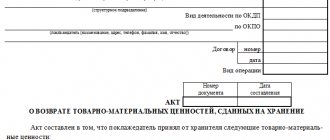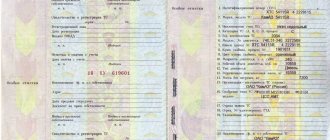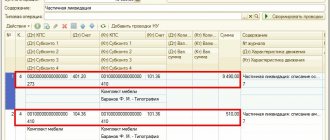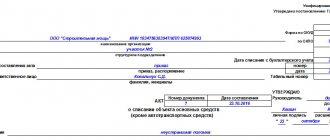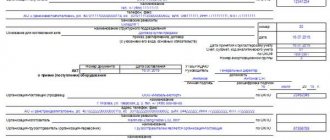Form of the act
To draw up the act, the unified form OS-4 is used. The form is filled out and executed when writing off fixed assets that have become unusable and there is no way to continue using them.
However, this form is not used for all operating systems. For example, if we are talking about fixed assets that relate to road transport, the OS-4a form is used. The need to draw up a different form is explained by the fact that when decommissioning a vehicle, it is necessary to indicate many additional characteristics, for example, mileage data, serial numbers of parts and documents, information about deregistration.
In addition, there is also the OS-4b form. It is used when several fixed assets are subject to write-off at once.
The procedure for writing off fixed assets
The write-off process must be reflected in the financial statements. This is recorded in income and expenses. Accounting not only records the disposal of property, but also indicates additional information:
- residual value of the object;
- wear and tear cost;
- the amount of profit upon the possible sale of property.
As a rule, debiting begins with the opening of account 01. Additionally, a subaccount is opened for it.
It is worth remembering that if property is moved between the structures of one company, this cannot be considered a disposal. Also, property that has undergone reconstruction or installation of auxiliary equipment is not subject to write-off.
Nuances of filling out the act of writing off the operating system
The act consists of 3 sections.
Section 1 reflects information about the condition of the object as of the date of write-off, including:
- initial (replacement) cost;
- the amount of depreciation accrued from the beginning of operation of the facility;
- residual value of the operating system.
If the object has been revalued, column 7 indicates the replacement cost based on the results of the last revaluation. For non-revalued objects, their original cost is indicated on the date of acceptance for accounting.
About the revaluation of fixed assets and its role for different types of accounting, read the article “Why is the revaluation of fixed assets (fixed assets) necessary?”
Section 2 provides a brief individual description of the OS (devices, accessories, content of precious metals), and also provides the commission’s conclusion on the condition of the object and the possibility (impossibility) of its further operation.
Section 3 contains information about the costs associated with the write-off of fixed assets and the remaining usable inventory items after write-off.
You can view a sample of filling out the unified form OS-4 on our website.
How to correctly draw up an act of write-off of fixed assets
Since sooner or later an enterprise has to make a write-off, every accountant must be able to correctly formalize this procedure. This allows the company to always display the real situation with the property on the company’s balance sheet.
Various objects are subject to write-off:
- faulty transport;
- dilapidated buildings;
- outdated equipment;
- other property.
The main reason for write-off is the unsuitability of the property. The main condition is that it cannot be repaired or restored. This is determined by a specially created commission. However, if we are talking about technically complex property, it is unlikely that it will be possible to do without an expert opinion. For example, the air conditioner broke down. Company employees visually see only non-working equipment. An opinion on its malfunction can only be given by a specialist provided by the relevant company.
( Video : “Write-off of fixed assets - accounting”)
Even if the faulty equipment can be repaired, the service company must provide a full estimate to fix the problem. This will allow you to determine the economic benefit of the repair. If repair is not practical, the equipment is subject to write-off. Thus, it is the expert’s opinion that allows you to determine whether faulty OS can be written off.
How to fill out form OS-4b?
The unified form OS-4b was approved by the State Statistics Committee of the Russian Federation by resolution No. 7 dated January 21, 2003, together with many other forms used by enterprises. Currently, the use of the form given in the resolution is optional. It has moved to recommended status, which means the following: companies can invent the form of the act on their own, providing all the necessary sections in it.
However, it is known from business practice that business entities prefer to use an existing template. Additions to it are rarely made due to the high information content of the standard form. Basically, this form is shortened a little, leaving only the necessary columns.
Form OS-4b is a sheet, graphed on both sides. The front block must contain the following information:
- company name and personal data of employees responsible for the safety of the OS;
- the number of the act, the date when it was drawn up, the approving signature of the head of the organization;
- information about the state of the assets subject to write-off as of the date of the document.
The following information is reflected on the back:
- the commission’s verdict on the possibility of write-off, certified by the signatures of the organization’s employees;
- whether the valuables obtained as a result of dismantling the write-off object have been capitalized (and also whether they have been sold).
Instructions for filling out an act for write-off of fixed assets
The form has three sections. Each of them is designed to display specific information. An accounting employee is responsible for filling out the document. This can also be done by an employee who is responsible for the safety of fixed assets. In addition, a special commission is created that is directly involved in drawing up the act. Filling is carried out in four stages:
- Title page . Designed to indicate the company name. If the property belongs to a specific department or division, it is also indicated. The write-off is carried out on the basis of an order, therefore the date of its preparation and number are indicated on the title page. The date of direct write-off of the property is also indicated. Here you can see a column intended to indicate the reason for the write-off. This may be wear and tear, inappropriate repair, or physical aging.
- First table . Information and characteristics of the OS are entered here. The name of the product being written off, its serial and inventory numbers, the date of issue and registration with the organization must be indicated here. The relevant columns indicate the actual service life of the object, its initial cost and wear and tear costs.
- Second table . Additional data about the means is indicated here, for example, the materials that make up the OS. This table is filled out by members of the commission, confirming that the property is truly unsuitable for further use. The commission also gives its conclusion and detailed reason for the write-off. Each participant signs the document.
- Third table . Filled out by an accounting employee who calculates finances associated with the property being written off. If dismantling the OS required monetary costs, this must also be indicated in the document.
The document is completed in two copies. One of them remains with the employee who was financially responsible for this object. The second copy is transferred to the accounting department, where the official write-off is carried out.
Filling out OS-4b
The form has a front and back side. Both must be filled out.
Front side of OS-4b
When filling out the header, you must indicate: the name of the organization, the name of the structural unit, OKUD and OKPO, the date when the object was written off from accounting, the full name and personnel number of the responsible person.
Next, note the number and date of preparation of the document to be filled out. Nearby there are fields for approval by the manager of the write-off. They are filled in at the very end.
Then the main part begins - on the front page it consists of a table with information about the state of OS objects. What you need to indicate in columns 1 to 8:
- Record number in order. Only one row in the table should be allocated for each object.
- OS object name.
- Inventory number.
- The actual operating life of the OS object.
- Initial or replacement cost.
- The amount of accrued depreciation.
- Residual value. It is calculated by finding the difference between the indicators in columns 5 and 6.
- Reason for write-off. This could be a breakdown, moral or physical wear and tear, or theft.
If the OS object contains precious metals, then fill out columns 9 to 13: indicate the name, item number, units of measurement, quantity and weight of raw materials.
Reverse side of OS-4b
Here the commission that conducted the inspection must write a conclusion. The chairman and members of the commission must sign, confirming the accuracy of the specified data.
Then there is a table with information about what material assets the company received from the write-off of fixed assets. This part is filled out in the accounting department. You must enter the following information:
- A document on the sale of valuables remaining from the OS object and its details.
- Name, item number, unit of measurement, quantity, cost of materiel.
- Correspondence of accounts.
- Serial number in the materials accounting card according to form M-17.
At the end of the table, the cost of all materiel values is summed up. Then indicate the results of the write-off, and write in words the amount of proceeds from the sale.
After this, the document is signed by the chief accountant and approved by the manager.
Is it possible not to draw up an act?
When an object or equipment registered with an enterprise is written off, a corresponding mark is made on the inventory card. This is what the company's accounting department does. However, the basis for performing this procedure is the executed act of write-off of the fixed assets. It is also necessary for accounting purposes aimed at write-offs. Thus, without drawing up an act, it will not be possible to officially write off the property on the balance sheet of the enterprise.
Like other valid documents, the write-off act must be kept in the accounting department. After the expiration date, the document is sent to the organization’s archive for storage. He has been here for at least three years. There may also be a longer storage of the act, if this is provided for by the standards established by the organization.
When drawing up the act, try to avoid questionable wording of the reason for the write-off. The commission's conclusion should not raise additional questions for the inspection authorities. There are often situations when an accountant is accused of illegally writing off property, which may result in a fine. However, this employee only displays the write-off of the fixed assets in accounting. Although the accountant’s responsibilities do not include checking the commission’s conclusion and the grounds for write-off, it is still recommended to do so. The accountant must ensure that the commission's decision is as convincing as possible.
Purpose of the form
OS-4b refers to unified forms, and was approved by Resolution of the State Statistics Committee No. 7 of January 21, 2003. Must be used for write-offs.
Unlike OS-4, this act involves the introduction of information about group objects. After drawing up an act on the write-off of groups of fixed assets, before handing it over to the accountant, the form must be signed by a specially created commission and approved by the director of the organization.
If one copy is to be transferred to the work of an accountant for further accounting, then the second is deposited with the responsible employee, whose authority is to control the safety of the OS. Based on this document, an employee can deliver the groups specified in it to a warehouse and sell material assets and scrap metal.
Write-off is carried out in a situation where part of the operating system of a legal entity is recognized as worn out from the point of view of physical and moral indicators. The decommissioned objects cannot be further used, and their operation in the future is not economically feasible.
The basis for the write-off procedure is a separate liquidation order signed by the manager, as well as an act drawn up by the commission on the inadmissibility of the subsequent use of the specified fixed assets in the company's activities.
Sample act on write-off of groups of fixed assets:
From an accounting point of view, the OS-4b form confirms the fact of disposal of a group of objects, as well as the write-off of the specified fixed assets from the corresponding account 01. The signing of the act serves as a reason for the accountant to stop accruing amounts for depreciation of fixed assets, as well as adjusting the base for calculating property tax, starting from the month subsequent to the write-off procedure.
As a result of write-off, materials may appear in the organization that are suitable for further use in the process of supporting the activities of the enterprise. An example is the use of individual parts that, after decommissioning the operating system, are considered suitable. If available, the receipt of these components is registered at the expected prices. Acceptance is documented using Form M-11.
Information about the liquidation that occurred must be entered into the OS-6 inventory cards or reflected in the OS-6b book (used by organizations classified as small businesses).
The act of destroying the organization’s seal is signed by the members of the commission and approved by the head. In what cases is a “Report on Identified Equipment Defects” drawn up (Form N OS-16) - you can find out here.



